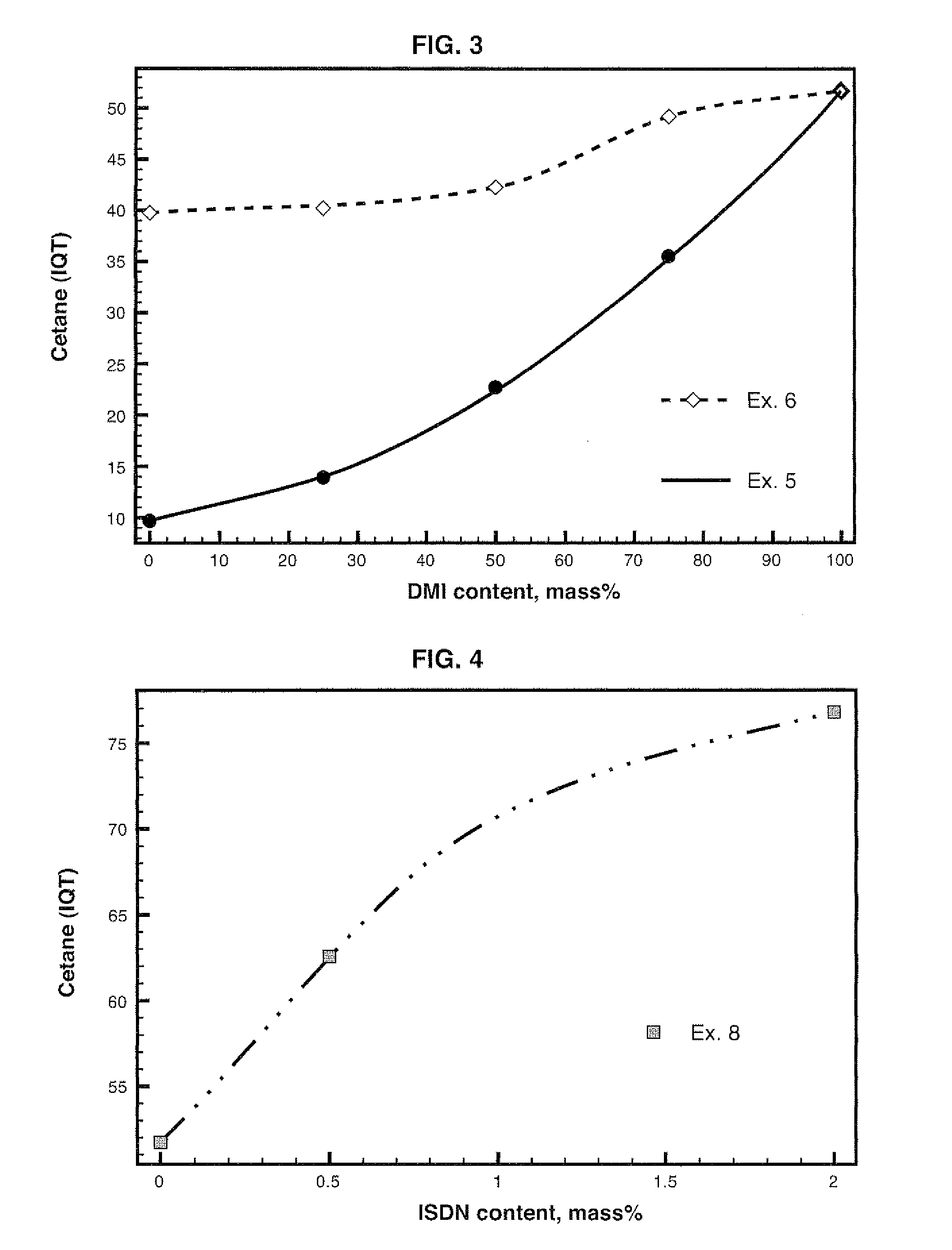Diesel cycle fuel compositions containing dianhydrohexitols and related products
a technology of dianhydrohexitol and fuel composition, which is applied in the direction of biofuels, fuel additives, liquid carbonaceous fuels, etc., can solve the problems of requiring further refining, low thermal process efficiency, and difficulty in utilizing fast pyrolysis bio-oils as fuels
- Summary
- Abstract
- Description
- Claims
- Application Information
AI Technical Summary
Problems solved by technology
Method used
Image
Examples
example 1
[0120]This Example is a Control Example.
[0121]The effect of the cetane improver more commonly employed, 2-ethyl-(hexyl-nitrate (2EHN) has been determined on a typical hydrotreated petroleum-derived diesel fuel.
[0122]Diesel fuel density at 20 / 4° C. was 0.8798, sulfur content 154 ppm and analysis by gas chromatography coupled to mass spectrometry (GC / MS) indicated composition 16.5 mass % paraffins, 40.6 mass % naphthenic compounds, 27.6 mass % monoaromatics, 12.2 mass % diaromatics and 2 mass % triaromatics.
[0123]Several 2EHN contents were added to the hydrotreated diesel fuel of the Example and the ignition delay expressed as estimated cetane or IQT was determined by the IQT (Ignition Quality Tester) ASTM Method D6890.
[0124]Table 1 lists the diesel fuel IQT values and those of mixtures of diesel fuel and 2EHN.
TABLE 12EHN content,mass %cetane IQT039.770.0541.680.145.590.547.37
[0125]A typical increase in 2 cetane numbers for 500 ppm 2EHN was observed.
example 2
[0126]This Example illustrates the preparation and utilization of isosorbide dinitrate (ISDN) as a combustion improver additive in diesel fuel compositions.
[0127]A sulfonitric solution was prepared containing 100 mL H2SO4 98% and 70 mL HNO3 68%. The mixture was kept under agitation in a bath cooled at 0° C., 160 g trichloromethane being added as well. An isosorbide solution, 25 g dissolved in 6.5 g water was added dropwise so that the temperature would not go above 8° C.
[0128]After 30 minutes the mixture was added to 300 g ice. The organic phase was separated, washed with sodium bicarbonate solution for removal of the dissolved acid and the solvent removed in a rotary evaporator. Nearly 32 g product was recovered. The sample was cooled resulting in crystallization. Elementary analysis of the material indicated C=30.77% H=3.41% 0=53.97% N=11.77%. The isosorbide dinitrate formula (ISDN) is C6H8O8N2, which equals to 30.52% C, 3.41% H, 54.20% 0 and 11.86% N. The comparison shows that IS...
example 3
[0132]This Example shows the utilization of isosorbide as fuel in a Diesel cycle engine.
[0133]Dissolution of isosorbide in water and ethanol was obtained. The amount was 80 mass % isosorbide, 10 mass % ethanol and 10 mass % water. Isosorbide dinitrate was added to the mixture of isosorbide, ethanol and water. IQT analysis data for mixtures with ISDN are listed in Table 3.
[0134]The 2EHN combustion improver was also utilized, at treat rates of 0.1 mass %, 0.5 mass % and 2 mass %. For the 0.5 mass % and 2 mass % rates there was phase separation (indicated by turbidity in the mixture and later formation of a non polar phase at the top, compatible with the 2EHN volume added).
[0135]The IQT analysis of the isosorbide, ethanol and water mixture at 0.5 mass % 2EHN was 10.32.
TABLE 3ISDN content,mass %cetane IQT09.690.110.670.510.891.011.422.012.135.016.75
[0136]Example 3 shows that the 2EHN combustion improver usually employed in the art is not suitable for a more polar character fuel mixture....
PUM
 Login to View More
Login to View More Abstract
Description
Claims
Application Information
 Login to View More
Login to View More - R&D
- Intellectual Property
- Life Sciences
- Materials
- Tech Scout
- Unparalleled Data Quality
- Higher Quality Content
- 60% Fewer Hallucinations
Browse by: Latest US Patents, China's latest patents, Technical Efficacy Thesaurus, Application Domain, Technology Topic, Popular Technical Reports.
© 2025 PatSnap. All rights reserved.Legal|Privacy policy|Modern Slavery Act Transparency Statement|Sitemap|About US| Contact US: help@patsnap.com



